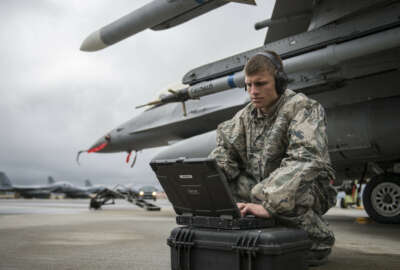Data organization is holding back the Advanced Battle Management System
The Air Force’s top general says moving data and making it accessible is the most important and most challenging task for the service as it continues its effo...
The Air Force’s top general says moving data and making it accessible is the most important and most challenging task for the service as it continues its effort to set up the Advanced Battle Management System.
That program is a key component of Joint All Domain Command and Control (JADC2) — the military’s attempt at an all-seeing eye for warfare that will incorporate artificial intelligence and real time knowledge to make decisions and facilitate attacks.
Air Force Chief of Staff Gen. C.Q. Brown said harnessing the data the Air Force has and getting it to the right areas is much more important than other benchmarks for the Advanced Battle Management System (ABMS).
“If I had one key area that stands out to me, it’s how we move data,” Brown said Wednesday during a Mitchell Institute for Aerospace Studies event. “We have a lot of data. I always joke in other jobs it’s probably on the shared drive someplace. We just don’t know where to find it. It’s like how we all have our drives at home on our own home computer. You’ve got millions of files, and all the data is there, but it’s not organized.”
Brown said he is working with Air Force acquisition chief Will Roper on how to publish data efficiently and make it so other areas of the military can subscribe to that data and pull it when they need it.
“It’s less about connecting a specific platform to capability, but having the data out there,” Brown said. “You can always just publish your data and then those who want it can actually download and subscribe to help build their other picture a bit better.”
Part of building that full picture with data is building trust between services so that they can share data and tools without reinventing the wheel with each service.
Brown said the branches need to work on reciprocity so if one service wants to add a tool to the system, then the other services don’t need to “grade the homework” on the tool.
“We ought to have a standard that once one of us does it; it should be good for all of us,” Brown said. “All we do is burn daylight and time and money to do extra checks. Part of that is how we do that so we can actually connect a bit faster.”
Lt. Gen. Chance Saltzman, deputy chief of space operations for operations, cyber and nuclear for the Space Force, said last week that the Pentagon agreed with Brown that data is one of the big issues with ABMS and JADC2.
He said the Pentagon may need to completely revamp its policies around data to allow the flow the systems will need. He stated that currently there are issues around sharing information across multiple security layers and that stovepipes within the Defense Department are keeping data from moving into cloud-based structures.
“We’re still a little bit locked in an older mindset, if you will, about how to manage data in the more responsive way that’s required by JADC2,” he said.
JADC2 is supposed to be the future of military awareness.
The Congressional Research Service gave a good account of what JADC2 looks like:
“DoD makes an analogy with the ridesharing service Uber. The Uber application calculates a user’s geographic position and the position of available drivers. It transmits information over a cellular or Wi-Fi network and matches the customer to the ride through artificial intelligence and machine learning,” the report states. “The user’s screen provides situational awareness of his or her position, identifies features in the vicinity, the location of the driver, supports data exchanges, and can coordinate multiple responses and riders in the same car. The military services contend that enhancing old processes and capabilities is insufficient. Each service is advocating for this type of advanced technology to support operations in a highly contested fight, ensuring not just cars, but aircraft, munitions, satellites, ships, submarines, tanks, and people are at the right place at the right time prosecuting the right target with the right effects, in seconds.”
ABMS is the part of the JADC2 that rapidly collects, analyzes and shares data.
The other services are working on delivering global and joint fires, and how to deal with logistics under attack.
Copyright © 2024 Federal News Network. All rights reserved. This website is not intended for users located within the European Economic Area.
Scott Maucione is a defense reporter for Federal News Network and reports on human capital, workforce and the Defense Department at-large.
Follow @smaucioneWFED





